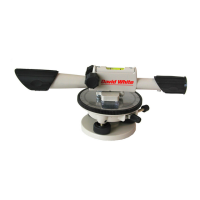In the above figure, A-B is the lot line. The
corner of the proposed swimming pool is
E. Point C is the point where the line
forming the side of the pool intersects this
lot line.
If E has not already been determined, set
up and level the instrument directly over
point C and line up the cross hairs on B.
Set horizontal circle to zero.
Turn the telescope 90 degrees to the
right. The vertical cross hair of the
instrument will now cut across point E and
point G. Measure the distance from the
lot line to the corner of the pool, which is
C-E. Also, the distance E-G is measured
along this line. Place a stake at points C,
E and G.
Next set up and level the instrument
directly over point E and line up the cross
hairs on G. Set reading to zero. Turn
the telescope 90 degrees to the left to
establish the line E-F. Measure out the
distance and place a stake at point F. The
distance, D-F, (from F to the lot line) will
exactly equal E-C if the work is correct.
Next set up and level the instrument over
point F and set the vertical cross hair at
point E. Set reading to zero.
Turn the telescope 90 degrees to the left
to establish the line F-H. Measure out the
distance and place a stake at point H.
Vertical Applications
(LT6-900 Only)
The following example illustrates how to
use a level-transit for laying out roads,
building lines, ditches, orchards, fences,
hedges, fields, etc.
Running straight lines with a level-transit
(Although it is possible to run straight lines
with a level, it is faster and more accurate
to use a level-transit.)
To run a straight line between stakes A
and E, position the instrument directly
over A.
After you level the instrument, release the
lock that holds the telescope in the level
position and swing the instrument until
point E is aligned with the vertical cross
hair.
Tighten the horizontal clamp so the
telescope can move only in a vertical
plane. By pointing the telescope up or
down, points B, C and D can be located.
Establishing vertical lines and planes
It is necessary to use a level-transit
instrument for taking vertical sights, such
as lining up a building wall, aligning piers
or fencing, ennas, plumbing windows or
doorways, etc.

